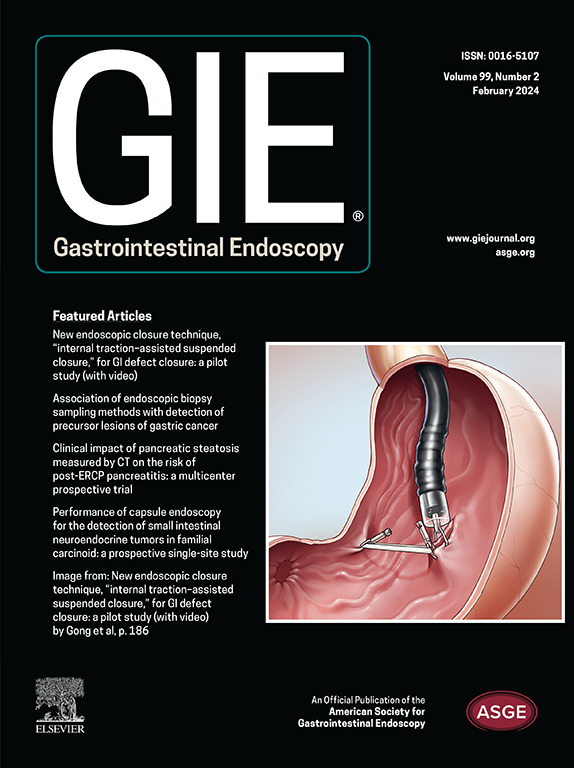比较柔性内窥镜针刀隔膜切除术和口周内窥镜肌切开术治疗禅克氏憩室。
IF 6.7
1区 医学
Q1 GASTROENTEROLOGY & HEPATOLOGY
引用次数: 0
摘要
背景和目的:泽纳克氏憩室(ZD)的治疗方法已从柔性内窥镜隔膜切除术(FES)发展到口腔内窥镜肌切开术(Z-POEM)。在这项研究中,我们比较了FES与针刀隔膜切除术(FENKS)和Z-POEM治疗症状性ZD的有效性和安全性:方法:研究人员对一家医疗机构中通过 FENKS 或 Z-POEM 进行内镜 ZD 治疗的连续患者进行了鉴定。对两组患者的人口统计学、临床特征、手术技术、技术和临床成功率以及 30 天内的不良事件(AEs)进行回顾和比较。不良反应按 AGREE 分类法进行分类。在 6 个月、12 个月和 24 个月时报告基线和术后 Dakkak 和 Bennett(DB)评分。临床成功率(DB评分≤1)通过协议分析(PP)和意向治疗分析(ITT)进行评估:60名患者(55%为男性,平均72±12岁)在2016年至2023年间接受了FENKS(21人)或Z-POEM(39人)治疗。基线临床特征相似,总体技术成功率为98.3%。根据干预后6、12和24个月的PP和ITT分析,两组的临床成功率相似。FENKS组的AE发生率(29%对5%,P=0.018)和严重程度(P=0.032)更高,治疗后更有可能住院(71%对33%,P=0.007)。在中位随访18个月期间,FENKS组(2人,9%)和Z-POEM组(3人,7.6%)中有5人(10%)需要再次干预(p=1.0),平均为初始治疗后7.6 ± 4.4个月:结论:用 Z-POEM 治疗 ZD 似乎比 FENKS 更安全,而且中短期临床疗效相似。本文章由计算机程序翻译,如有差异,请以英文原文为准。
Comparison of flexible endoscopic needle-knife septotomy and peroral endoscopic myotomy for treatment of Zenker's diverticulum
Background and Aims
Treatment of Zenker’s diverticulum (ZD) has evolved from flexible endoscopic septotomy (FES) to peroral endoscopic myotomy for ZD (Z-POEM). In this study, we compare the efficacy and safety of flexible endoscopic needle-knife septotomy (FENKS) and Z-POEM for symptomatic ZD.
Methods
Consecutive patients at a single institution who underwent endoscopic ZD treatment by FENKS or Z-POEM were identified. Demographics, clinical characteristics, procedure technique, technical and clinical success, and adverse events (AEs) within 30 days were reviewed and compared between the 2 groups. AEs were classified by the AGREE classification. Baseline and postprocedure Dakkak and Bennett (DB) scores were reported at 6, 12, and 24 months. Clinical success (DB score ≤1) was assessed by per-protocol (PP) and intention-to-treat analyses (ITT).
Results
Sixty patients (55% men; mean age, 72 ± 12 years) underwent FENKS (n = 21) or Z-POEM (n = 39) between 2016 and 2023. Baseline clinical characteristics were similar, and overall technical success was 98.3%. Clinical success by PP and ITT analyses at 6, 12, and 24 months after each intervention were similar between both groups. The FENKS group had a higher prevalence (29% vs 5%, P = .018) and severity (P = .032) of AEs and were more likely to be hospitalized after treatment (71% vs 33%, P = .007). During a median follow-up of 18 months, reintervention was required for 5 cases (10%), 2 (9%) in the FENKS and 3 (7.6%) in the Z-POEM group (P = 1.0) a mean 7.6 ± 4.4 months after initial therapy.
Conclusions
Treatment of ZD with Z-POEM appears to be safer than FENKS with similar short and midterm clinical success.
求助全文
通过发布文献求助,成功后即可免费获取论文全文。
去求助
来源期刊

Gastrointestinal endoscopy
医学-胃肠肝病学
CiteScore
10.30
自引率
7.80%
发文量
1441
审稿时长
38 days
期刊介绍:
Gastrointestinal Endoscopy is a journal publishing original, peer-reviewed articles on endoscopic procedures for studying, diagnosing, and treating digestive diseases. It covers outcomes research, prospective studies, and controlled trials of new endoscopic instruments and treatment methods. The online features include full-text articles, video and audio clips, and MEDLINE links. The journal serves as an international forum for the latest developments in the specialty, offering challenging reports from authorities worldwide. It also publishes abstracts of significant articles from other clinical publications, accompanied by expert commentaries.
 求助内容:
求助内容: 应助结果提醒方式:
应助结果提醒方式:


